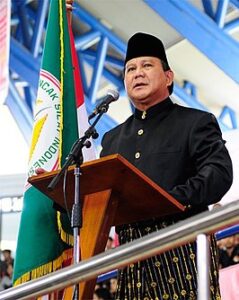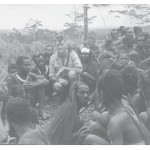Prabowo Subianto: Indonesia’s Defense Minister Poised For Presidency Amid Allegations Of Controversial Past

Prabowo Subianto – Source: nl.wikipedia.org
02-28-2024 ~ As preliminary results hint at Prabowo Subianto’s victory in Indonesia’s presidential race, political tension rises with Ganjar Pranowo and Anies Baswedan seeking an inquiry into alleged irregularities. Beyond the election drama, Indonesia grapples with persistent issues from economic struggles to foreign relations.
Prabowo Subianto, Indonesia’s defense minister and a former army general, is poised to become the next president of the country. Although the official results are due next month, preliminary figures indicate that Prabowo will secure close to 60 percent of the vote.
Two unsuccessful presidential candidates in Indonesia are calling for an official inquiry into the recent election. Ganjar Pranowo and Anies Baswedan have alleged widespread irregularities in the February 14 election, including instances of vote-buying and intimidation.
Indonesia, Southeast Asia’s largest economy and the world’s most populous Muslim-majority nation, shifted from a 32-year dictatorship to a democracy about 25 years ago. Despite progress, challenges persist like poverty, corruption, environmental degradation, and ethnic and religious divisions.
With vast natural resources, Indonesia actively seeks foreign investment for infrastructure and resource extraction and has strengthened commercial ties with China even while avoiding taking an active position in the escalating U.S.-China rivalry. In this regard, Prabowo will likely continue the policy of his predecessor outgoing President Joko Widodo.
Position by Candidate
The contest for the presidency saw a three-way race between Subianto and former governors Anies Baswedan and Ganjar Pranowo. Subianto, representing the Advanced Indonesia Coalition, is expected to get over 58.84 percent of the votes. Baswedan is likely to come in second with around 24.46 percent, while Pranowo of the Indonesian Democratic Party of Struggle (PDI-P) will come in third with around 16.7 percent of the votes.
Elections were also held for parliament in which 18 parties took part. Parties need to garner a minimum of 4 percent of the total national vote to obtain representation in parliament. In the 2019 elections, 20 parties were in the running, yet only eight successfully secured seats in the House. In this election, while results are yet to be finalized, far-right Islamist groups have suffered a setback.
This is the third time that 72-year-old Subianto, a 72-year-old military general and the son-in-law of dictator Suharto, contested for the presidency. In his earlier attempts in 2014 and 2019, he was defeated by Joko Widodo. This election, however, saw the old rivals coming together with Widodo’s son Gibran Rakabuming Raka, contesting as Subianto’s vice-presidential candidate. While Widodo, who remains immensely popular, did not explicitly back Subianto, the widespread perception was that the ticket had his support and there are allegations that state agencies backed the candidacy of the defense minister.
Subianto was in the thick of military affairs during the brutal Suharto dictatorship. He was a commander of the notorious Kopassus, the special forces unit of the Indonesian Army set up in 1952. The unit has been accused of involvement in torture, extrajudicial killings, and other human rights violations, particularly during periods of political unrest and conflict. Kopassus was alleged to have participated in rights violations in Timor-Leste where an independence movement culminated in its gaining independence in 2002 following UN intervention.
Prabowo himself was for a while barred from travel to the United States due to accusations of human rights violations. He was discharged from the military following similar accusations. In 2023, activists launched a campaign called ‘Don’t Vote for a Kidnapper’ highlighting his alleged involvement in the detention and disappearance of 13 activists who were active in the campaign against the Suharto dictatorship.
Critics have expressed concerns about Subianto’s record during this campaign considering the repression over the years in West Papua where protests have been met with arrests and internet shutdowns. For decades, the people of West Papua have fought against Indonesian occupation, advocating for the right to self-determination. In 2019, the region witnessed widespread protests against racism, intensifying tensions between Papuan demonstrators and security forces.
This election saw a concerted effort to whitewash Subianto’s image with the former general being rebranded as a genial elder. An entire generation has grown up with few memories of the horrors of the Suharto era and Subianto’s role. He also benefited from being seen as the candidate continuing the legacy of Widodo. The outgoing president had contested the previous two elections as the candidate of the center-left Indonesian Democratic Party of Struggle (PDI-P).
The political realignment in this election was one of the reasons for a campaign marked by the absence of any major policy alternatives. While some of Widodo’s decisions, such as the plan to shift the capital from Jakarta, saw much debate, there was little opposition to aspects of his economic legacy, such as the widely opposed Omnibus Bill and other issues raised by labor movements and environmental groups.
Subianto’s main rival was Anies Baswedan, the former governor of Jakarta, who was perhaps the candidate diverging the most from Widodo’s legacy. He was a key opponent of the plan to shift the capital and headed the right-wing Coalition of Change for Unity, garnering support from conservative Islamic groups. The other candidate, Ganjar Pranowo, the former governor of Central Java province who was once seen as a potential successor to Widodo, sought to highlight the PDI-P’s traditional welfarist agenda.
Economic Challenges and Ongoing Struggles
Indonesia has faced tough economic times in its history. There was the Asian Financial Crisis in the late 1990s, which caused a severe recession, social unrest, and the fall of the authoritarian regime led by Suharto. Then, in 2008-09, the global financial crisis brought a slowdown in growth, a bigger current account deficit, and a drop in the value of the country’s currency, the rupiah. The most recent challenge was the COVID-19 pandemic in 2020-21. It made the economy shrink, more people became poor and jobless, and public health and the value of the rupiah fell further. In 2021, the poverty rate in Indonesia stood at 10.15 percent, impacting 27.5 million people. Additionally, the unemployment rate for youth, as a percentage of the total labor force aged 15-24, remains at 14.1 percent.
Indonesia faces several ongoing challenges. One significant issue is the large number of people without jobs or with low-quality jobs, particularly those engaged in low-skilled and informal work. These individuals face difficulties when unexpected events occur, and they lack sufficient social protection. Additionally, Indonesia struggles with competitiveness and productivity due to insufficient infrastructure, a shortage of well-trained individuals, a lack of innovation, and governance issues. This is likely to lead to a decline in the manufacturing sector, a significant contributor to employment. In the long term, it is expected to contribute to a higher unemployment rate and a decline in the standard of living.
Another pressing concern is environmental degradation and climate change, posing risks to the country’s natural resources, biodiversity, and its ability to handle disasters. A survey by Bath University found that 89 percent of Indonesian participants were worried about the potential impact of climate change on their lives, with 66 percent believing they would be directly affected. The highest levels of concern were reported in disaster-prone provinces like Jakarta, South Sumatra, and North Sumatra.
The endorsement of a former Suharto-era general by significant factions of the Indonesian ruling class carries considerable weight. This support is notable in the midst of widespread protests sweeping across Indonesia, where millions are expressing opposition to Israel’s brutal actions in Gaza. Simultaneously, internal social tensions are on the rise due to declining living standards, adding a layer of complexity to the country’s political landscape. The official results and subsequent actions by the incoming administration will determine how Indonesia addresses its multifaceted problems and charts its course in the global arena.
By Pranjal Pandey
Author Bio: This article was produced by Globetrotter.
Pranjal Pandey, a journalist and editor located in Delhi, has edited seven books covering a range of issues available at LeftWord. You can explore his journalistic contributions on NewsClick.in.
Source: Globetrotter
On Friendship / (Collateral Damage) V – Between Graveyard And Museum’s Sphere
 On Friendship / (Collateral Damage) V – Between Graveyard and Museum’s Sphere
On Friendship / (Collateral Damage) V – Between Graveyard and Museum’s Sphere
Het Nieuwe Domein, Ligne 5, Sittard – 3.2.2024-30-6.2024
At first glance, a cemetery and a museum seem to have little in common. Yet they both give meaning to the artworks Joseph Sassoon Semah presents in the exhibition.
He takes the visitor on a wonderful journey of exploration from King Solomon’s Temple in Jerusalem, through Baghdad’s lost public space, the waiting room of his grandfather Sassoon Kadoori (1886-1971), the chief rabbi of Baghdad, and the Auschwitz-Birkenau extermination camp, to spatial architecture based on the Talmud Bavli.
Performance
Joseph Sassoon Semah, Peter Baren, Masja Austen, Emile Schrijver, Ulco Mes, Theresie Tholen, Aletha Steijns, Jom Semah
Camera & Editing: Bob Schoo. www.n-p-n.info
Outdated Narratives Have Humanity In A Downward Spiral—It’s Time To Tell ‘Stories for Life’

April M. Short
02-24-2024 ~ A short film and narratives project “Stories for Life” seeks to bring about the shift in culture that humanity needs to survive.
The stories we do and don’t tell about ourselves and these times in which we’re living shape the direction of our lives and our cultures. Stories have the power to alter how we interact and relate. Those who study cultural anthropology and the origins of humanity are finding that cultural stories—the things people collectively believe about ourselves and our capacities—have forever shaped human societies, going back to our early hominid ancestors. In shifting those narratives now, they argue, we have the realistic potential to evolve on purpose as a species. Given the dire, multifront crises of our times—from climate disaster to war to poverty—this kind of cultural and social evolution is desperately needed.
An animated short film, which screened between acts on the big screens of each of the four main stages at the Glastonbury Music Festival in 2022, delves into the idea of story as a means for change. It is titled, “Stories for Life,” and it opens with scenes of fire, a child digging through a pile of trash, plastic rubbage floating in the water, and smoke billowing from an industrial tower. A narrator’s voice speaks over the imagery: “Life is in trouble. As a species, we are facing multiple crises that we can no longer ignore. At the root of them all is our economy; an economy designed to destroy life; an economy designed by us.”
As the narration continues, a series of illustrated signs seem to lay out the challenges of our world, one by one: “Capitalism is crashing. Society is dividing. Democracy is degrading. Climate is tipping. Ecology is vanishing. Disease is spreading. Inequity is rising. Protest is pervading.”
The film takes viewers through a brief history of humanity’s relationship with the Earth. It delves into the problems of our current ways of living, then offers the potential to rewrite the story of our values, and begin to create livable systems in which value is based on the well-being of all life.
Over animations of cave paintings, constellations, and wildlife, the film reminds viewers that “our ancestors lived in intimate relationship with the more-than-human world” and told stories about, “nature as our family, our guardian, our guide. But then some of… [our ancestors] imagined and created ways to control the natural world. This made them feel more powerful and superior to nature. Separate from it. The more powerful they felt the more disconnected from nature they became. And so they began to tell new stories. Stories that normalized domination, control, and the oppression of life. About how nature is our slave, there to be captured and exploited. They began to scorch, spoil, and suffocate our world. And as they did so, these stories spread, and became common sense.”
This narration comes with animations of the industrialization and commodification of resources: factories, men in suits and wigs, ships with cargo. The film goes on to explain that such stories have led people down the path of greed, grand, hustle, and blind progress, and made people “feel separate, not only from nature but from each other, in constant competition and conflict.”
Horror Stories, Love Stories
The narrator notes that these stories then became horror stories of ruined lives and a ruined world, as images of refugee camps, rubbage heaps, and melting ice caps show on screen. “But, it doesn’t have to go on like this,” the narrator says. “We can choose to live by different stories: Love stories about interconnection and interdependence. Love stories that measure success by well-being—the well-being of all life including our own. Love stories about interconnection and interdependence.” Now, the scene is blooming flowers, mycelial networks, collaborative groups of people, and brightly colored animal life.
The film outlines how these “love stories” will lead us to reconnection, so that we can regenerate our relationships with nature and each other, and create a steam that nourishes and supports the life we all want to live rather than destroying life. It closes with the reminder that “we all have the power to tell these stories,” and that many people are already doing so.
The concept behind the film is part of a larger website project launched in 2020, also called Stories for Life, aimed at highlighting stories that support ways forward for humanity and all life. It began as a collaboration between the Green Economy Coalition, Wellbeing Economy Alliance, and the Spaceship Earth, and as its website states: “This project was inspired by the question ‘how do we tell the story of a new economy?’”
The eventual Stories for Life project was co-created by Dan Burgess and Paddy Loughman with the purpose of helping to “create stories that contribute to the re-design of a healthier economy. To bring forth new and ancient stories into our culture, which weave a narrative of interconnection and help us design a new type of economy,” as notes the Stories for Life website.
Understanding Iran’s Non-State Network

John P. Ruehl – Source: Independent Media Institute
02-22-2024 ~ Recent months have brought sharper focus to Iran’s network of non-state actors across the Middle East. While useful for military projection, Tehran has also cultivated them as political entities for decades.
During a three-day period in January 2024, Iranian-supported militant groups employed an anti-ship missile to attack an oil tanker in the Red Sea, launched rockets into northern Israel from Lebanon, and used a drone strike to kill three U.S. soldiers in Jordan. These incidents marked the extension of attacks by Iranian-backed groups in the Middle East into the fourth straight month since the outbreak of the Israel-Hamas war on October 7, 2023.
Largely diplomatically isolated since the 1979 Iranian Revolution, unable to challenge U.S. military power, and lacking the nuclear brinkmanship card held by North Korea, Iran has evolved its strategy of utilizing militant groups for decades. Iran’s Quds Force has provided training, funding, and weapons assistance to various militant groups in the region, including Hamas, Hezbollah, and the Houthis. This strategy has advanced Iran’s geopolitical interests and afforded it plausible deniability, but not all of its associates march in lockstep with Tehran.
Part of Iran’s approach involves transforming militant forces into powerful political actors. Hamas, founded in 1987 as an offshoot of the Muslim Brotherhood, gained prominence during the First Intifada against Israeli forces. Hamas grew closer to Iran during the early 1990s after the Oslo Accords initiated an ultimately failed peace process, with Iran providing financial and weapons support during the Second Intifada from 2000 to 2005. When Israeli forces withdrew from Gaza in 2005, Hamas established administrative control over the territory after winning elections the following year, and has forbade elections since.
Consolidating armed Palestinian opposition under Hamas allows Tehran to challenge Israel directly. But as a Persian and Shia Muslim country operating in a predominantly Arab and Sunni Muslim peninsula, Iran has offset its diplomatic and cultural isolation by using the Palestinian cause to criticize Arab governments growing closer to Israel in recent years. Supporting Hamas against perceived inaction from Arab leaders has been a constant feature of Iranian public messaging. Further normalization between Israel and Arab states is now paused due to the Israel-Hamas war. Read more
Growing Clues That India’s Central Narmada Valley Was A Key Hub In The Human Story
02-22-2024 ~ In December 1982, a geologist digging in India’s Central Narmada Valley found something he did not expect. Arun Sonakia, who at the time worked for the Geological Survey of India, unearthed a hominid fossil skullcap from the Pleistocene era.
The discovery sent shockwaves through the field of paleoanthropology and put South Asia on the map of human prehistory. Some experts concluded that the skull likely belonged to a member of a predecessor species of ours, Homo heidelbergensis, or perhaps was a hybrid of homo species, while Sonakia himself suggested “an affinity… to Homo erectus.”
The specimen remains the oldest human fossil found in the South Asian subcontinent; while expert opinions vary, testing seems to indicate the fossil was between 250,000 and 150,000 years old. For several decades, it was the only ancient human fossil found in South Asia—despite abundant finds of tools and other relics.
But in more recent years, more than a dozen other fossil bones that have been discovered have shined a light on the Central Narmada Valley as a potential hotbed of human evolutionary activity. Paleoanthropologist Anek R. Sankhyan and his team discovered new fossils between 1983 and 1992, followed by further finds between 2005 and 2010.
Sankhyan shared during an interview that only the Central Narmada Valley has so far yielded human fossils from the Pleistocene period in South Asia. The valley, he says, was a key stop along the migration route from Africa to Southeast Asia for Homo erectus. Homo erectus was an archaic human ancestor that lived between about 1.9 million and 100,000 years ago and adapted to regions from Eastern Africa to China to Southeast Asia. It has not been established whether Homo erectus comprises one species spread wide geographically or multiple species involving local variations.
Sankhyan connects the Narmada Valley with some of the more sophisticated Acheulean stone tool cultures that emerged with Homo erectus in Europe and Africa. Acheulean tools are characterized by multiuse-hand axes used for roles ranging from woodcutting to butchering animals.
In the Central Narmada Valley, Sankhyan’s evidence from his paper—published in Advances in Anthropology in 2020—on the subject seems to show at least two distinct types of hominins represented: the large “robust” line uncovered through Sonakia’s skullcap discovery, and an evolving “short and stocky” hominin line from 150,000 to 40,000 years ago discovered by Sankhyan and his team.
Sankhyan says that the traits of the skullcap found by Sonakia vary among Homo erectus, Homo sapiens , and have features that are unique, making identifying it “confusing.” He concluded that the skullcap is also representative of heidelbergensis, and perhaps might be a heidelbergensis -Neanderthal hybrid. A skull with so many traits is a clue that this region may indeed have been a multispecies melting pot that puts our contemporary sense of human differences to shame.
Heidelbergensis was a species that was the ancestor of both Neanderthals and Homo sapiens, and first appeared 700,000 years ago, disappearing 200,000 years ago. It was an intermediate species between Homo erectusand modern human beings and Neandertals. Heidelbergensis was likely the first human species to control fire and hunt large game animals . The hominid fossil found by Sonakia likely used tools like an Acheulian pick axe and was found near a crushed molar tooth of a Stegodon, a large, extinct relative of today’s elephants. Sankhyan says that the ecology of the valley during the Lower Paleolithic was that of a warm woodland forest with megafauna like the Stegodon, during his interview.
The “short and stocky” line has been given its own nomenclature: Homo narmadensis by Sankhyan. This species was widespread in the Central Narmada Valley during the “Middle to Upper Paleolithic [era],” and hunted smaller game animals in a “broken forest ecology.” Narmadensis was discovered near significant numbers of Mode 3 Acheulean tools, which are more sophisticated than the Mode 2 tools attributed to the heidelbergensisline.
Paleoanthropologist Sankhyan speculates that the “short and stocky” hominin line was the “likely precursor to the ‘short-bodied’ ancient populations of India, including the Andaman pygmy.” Interestingly, he believes that the so-called “hobbit” of Indonesia, Homo floresiensis, also descended from this line. Homo floresiensis was a little more than three-feet tall and lived between 100,000 and 50,000 years ago.
While Sankhyan says that the government organization, Anthropological Survey of India, has not conducted further excavations since 2010, according to him, there have been individuals from other departments who “tried sporadic trial digging,” but those digs have not yielded any significant results.
As research continues in this area, we’re likely to get even more insight into the varied hominin types who lived in the Central Narmada Valley in the last hundreds of thousands of years and how they interacted with one another. Regardless, the establishment of South Asia as a center of human evolutionary activity is likely to have consequences for how the region, and India in particular, understands itself and its prehistory and history.
For decades, nationalists, including representatives of today’s far-right Hindu nationalists in India, have promoted the idea that South Asians and Indo-Europeans as a whole originated from within India. Though this theory is false and unnuanced, the evolutionary history of hominins in the Central Narmada Valley offers new ground for Indian nationalists to make the argument that hominins or primates had their roots in India.
But if there are dangers in linking contemporary India with the prehistory of the subcontinent and its place in the world, there are also opportunities. As with India, fossil evidence in South Africa, Kenya, Tanzania, Georgia, and China indicates that these places were repeatedly home to prehistoric population centers—they all have equal claim to being part of a global and gradual humanization process.
As a result, a nonaligned or regionally connected Global South has a powerful new origin story and better pathways for connections, rooted in evidence outside of the historical narratives imposed on them by the West. Further research will establish what science shows, but it will be politics, geopolitics, and the direction chosen by the world’s people that will contextualize the evidence within the human story.
By Saurav Sarkar
Author Bio: This article was produced by Globetrotter .
Saurav Sarkar is a freelance movement writer, editor, and activist living in Long Island, New York. They have also lived in New York City, New Delhi, London, and Washington, D.C. Follow them on Twitter @sauravthewriter and at sauravsarkar.com.
Source: Globetrotter
The Great ‘Japa’ Movement: A Blessing In Disguise, Not A Cry For Help

Adekunle Olajide
02-21-2024 ~ Introduction
Many Nigerians have been leaving the country in search of better opportunities in other countries, a trend that is widely known as the ‘Japa Syndrome’. This has caused a lot of controversy and sparked a lot of debate on the popular social media platform, Twitter (now X), where many users have forecasted a bleak future for the economic situation of Nigeria owing to this mass migration.
The recent change of government, with President Bola Ahmed becoming the new leader, is regarded by majority of the youth as the final reason that made them embrace the ‘Japa’ movement – a buzz word that has taken a rightful place in Nigeria’s urban lexicon.
However, those pressing the panic button may not be seeing the bigger picture. Only a few people have looked at the situation in-depth, like a Chess Master who evaluates all the possible scenarios before making his next move. Calling the current trend, a disaster for the Nigerian economy, is like a beginner chess player who only sees the board from one angle.
Have Nigerians actually taken a moment to consider that, beyond the mere surface, this whole ‘Japa’ movement might actually not be a cry for help situation, but rather a blessing in disguise?
If we can just take a step back and distance ourselves from the noise on social media or opinions of internet trolls and consider the long-term prospects of the ‘Japa’ movement. Perhaps, amidst the buzz, we will start to see the movement as the silver lining and driving force for our socio-economic and political resurgence and development.
Nothing is New under the Sun – Not even the Great ‘Japa’ Movement.
The concept of movement is one that has been ingrained in the very fabric of our humanity, a universal trait inherent in our nature that cannot be blotted out. It is often stated that ‘movement is merely a construct of globalization’ and that by nature, humans are peripatetic beings—beings with an instinctual desire to move from one place to another in search of opportunities or desires, be they material or incorporeal desideratum. This stands as both an anthropological standpoint and an undeniable fact!
Against this backdrop, it suffices to say that there, indeed, nothing new under the sun. The mass exodus of Nigerians, or the Great ‘Japa’ Movement, as I comically dubbed it, is not a novel phenomenon but rather a contemporary echo of historical migration patterns. The only distinction lies in the amplified buzz created by social media, turning it into a sensationalized narrative, as if it is the next big thing since sliced bread.
From a historical perspective, the genesis of the ‘Japa’ movement can be traced to the 1980s, a period of military transitions, socio-economic breakdowns, and political maladministration in Nigeria. Following that, the movement took form during the urbanization wave in the country, a period when the ambitious youths migrated from their villages and hometowns to the cities, notably Lagos, Abuja, or Port-Harcourt, seeking improved working conditions and greener pastures. This trend, which was once overlooked despite its impact on agricultural productivity, has taken on a whole new level, and now we want to kick against it? So Nigerian!
Let’s also not forget the darker times, when Nigerians and other Africans, in their quest to find better pastures, undertook life-threatening sojourns and illegal terrains through the great Sahara and crossing the Mediterranean in search of a better life. This movement is neither new nor did it started last years; it started way back!
Legitimacy and Legal Standpoint on Migration.
Moving on from historical records to the contemporary legal landscape, there are clearly established legal policies that fully legitimizes migration.
To begin, Section 41 of the 1999 Constitution of the Federal Republic of Nigeria affirms the inalienable right of citizens to move in and out of their homeland. Articles 12 (2) of the African Charter on Human and People’s Rights (ACHPR) and Section 13(2) of the Universal Declaration of Human Rights (UDHR) further emphasize the universal right of citizens to leave any country, including their own, and to return to their homeland.
These cogent legal perspectives underscore the legitimacy of citizens to freely move in and out of their home country and the right of people to seek employment and better opportunities wherever they may find them.
Nigeria Deserve your Gratitude.
It is quite disheartening to see Nigerians, both at home and abroad, continually tarnishing the image of the country, describing it as inhospitable, unfavorable and a place where the dreams and aspirations of Nigerians die.
This negative narrative, which is primarily aimed at triggering angst and hatred towards the Nigerian government, is often fueled by half-truths, hyperbolic comments, and warped information. This category of individuals can only be viewed as uninformed, tunnel-visioned citizens with an entitlement mentality.
These entitled critics are not aware of the historical realities of the present world powers, most especially the United Kingdom (UK) that they so much endear as the land of the golden fleece. They are not aware that, at one point in time, countries like the UK emigrated from their country and went about colonizing, conquering, and pillaging the resources of other nations, and bringing it back into the coffers of their homeland. Most of these world powers of today once emigrated to other parts of the world before becoming influential global forces.
These set of uninformed countrymen and women have forgotten that before they left the country to make exploits, Nigeria was their training ground that laid the foundation for them to migrate out of the country. Most of the graduate professionals that are now thriving in diaspora did receive their first-degree education in Nigerian tertiary institutions before leaving. Can they compare the cost of acquiring a competitive degree in Nigeria to anywhere else in the world?
Most people failed to notice that the Nigeria public tertiary education is highly subsidized. Even in the early days, the federal government even sponsored the education of Nigerians studying overseas – our present and past university professors who got to study abroad on federal government scholarships can candidly attest being a beneficiary to the Nigerian government’s beneficiary.
At present, Nigeria’s public university students pay a minimal yearly tuition fee of about $25 to $75 yearly, for a period of 4 to 5 years to earn a competitive degree – an insignificant figure compared to what is obtainable in other parts of the world. Contrastingly, countries like the UK and USA require students to take on substantial student loans in order to finance their tertiary education.
Looking at the net migration figures, the population of Nigerians in the UK is still a fractional and insignificant figure compared to countries like India, Ukraine, Pakistan, and Poland. Latest figures published by the UK authorities showed that Nigeria is ranked in 7 th place in the net migration index.
Considering the cost of living abroad, as well as the tax burden and educational expenses abroad, it is evident that Nigeria has provided a facilitating platform for success. Nigerians and Africans, when abroad, often excel and achieve extraordinary feats, owing their success to the foundation laid in Nigeria.
So, in the grand scheme of things, the favourable immigration policies, the diplomatic ties Nigeria has built with several countries of the world, the education qualification, work experience, information, and exposure that Nigerians are a beneficiary of, were all made possible by the foundation and groundwork that Nigeria laid over the years.
Now, this article piece is not pontificating that the situation of Nigeria is thriving or that the country economy is all fine and dandy. No! It only aims to set the records straight and establish that the narrative has been brandished and misrepresented by not only the media to sell their stories, but also by some Nigerians in the diaspora who only seek to make worse of the current situation.
Yes, the country is not working as it should, but it is essential to establish that the situation is not as dire as it has been painted to be. Read more


